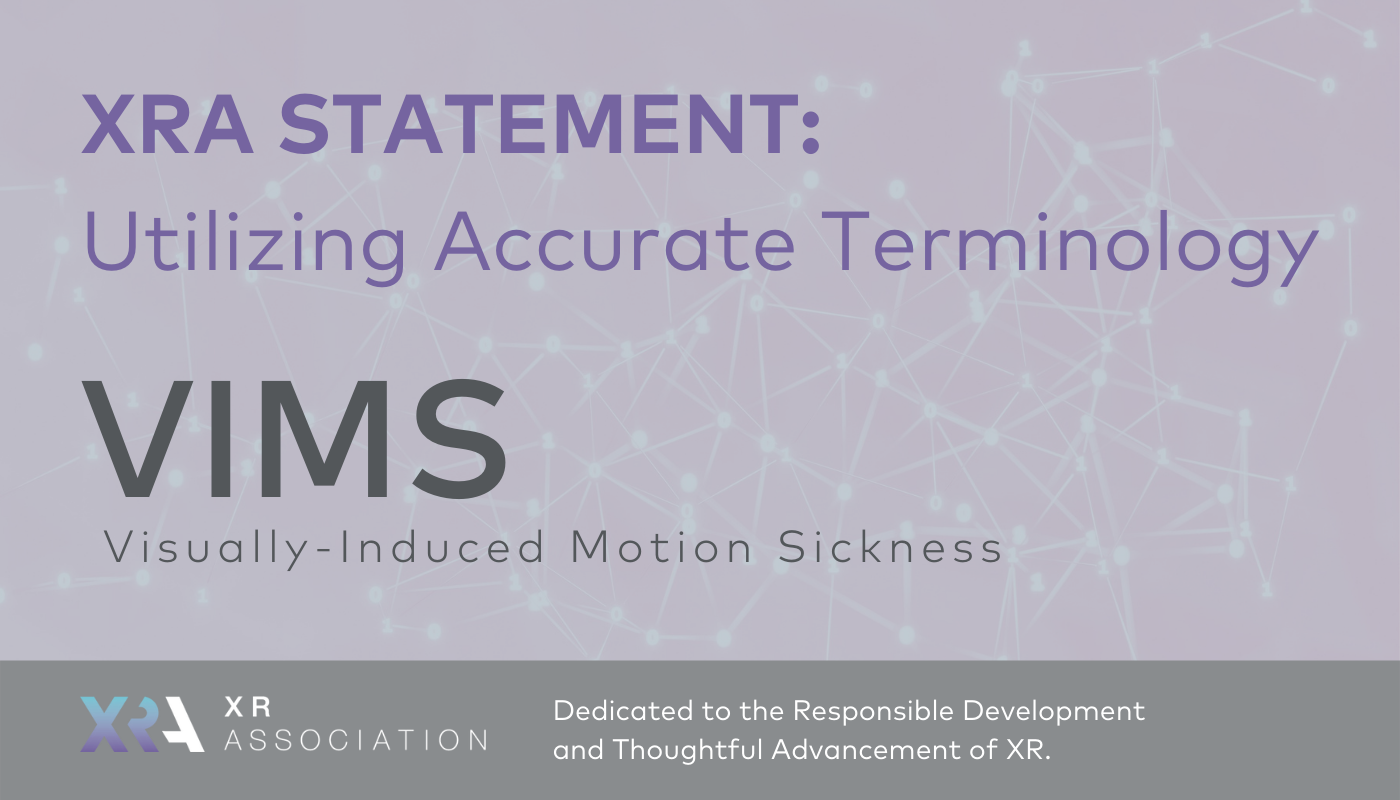UTILIZING ACCURATE TERMINOLOGY: VISUALLY-INDUCED MOTION SICKNESS (VIMS)

Utilizing Accurate Terminology to Describe Symptoms that May Arise from the Use of Extended Reality Equipment
Definition: Visually induced motion sickness (VIMS) is a subcategory of motion sickness that specifically relates to nausea, oculomotor strain, and disorientation from the perception of motion while remaining still (Kennedy et al., 2010).
As the XR industry works toward making XR experiences accessible to all, we also desire to have shared terms that we all understand. To that end we invite all members of the XR community to use the term “visually-induced motion sickness” or “VIMS” as defined above.
There are many terms, such as “cybersickness”, that are used to describe the symptoms of disorientation, dizziness, nausea, and eye strain that some users of XR technology may experience when engaging with devices and applications. These symptoms continue to receive attention in XR academic literature and media reports, and can be a barrier for some users in trying XR technologies. With so many terms in use it is difficult for the consumer to fully understand and assess the risks and rewards of engaging with XR technology.
To aid understanding of this phenomenon, XRA assessed peer-reviewed academic research on the occurrence of various symptoms and determined that a scientifically accurate and easily understandable term of art is “visually-induced motion sickness” or “VIMS.” We invite all members of the XR community to use the term “visually-induced motion sickness” or “VIMS” when referencing the occurrence of such symptoms following XR experiences.
While users of XR technology might not have considered it, many people have experienced motion sickness at some point or another during their life. Car sickness and seasickness are caused by the brain’s reaction to the divergence between what it sees and what the body is feeling. Indeed, people may also have experienced Visually Induced Motion Sickness before when watching a 3-D movie. This can be experienced when a scene in a fully immersive environment moves around the viewer, causing some viewers to feel like they are moving even though they are sitting. That feeling of moving, resulting in disorientation and dissociation, is VIMS.
As with motion sickness in other scenarios, experiences through use of XR technologies will be varied. Many users may never experience VIMS. Or they may experience it when using one application but not another. As software and hardware are designed, consideration should always be given to the user experience, making the experience as comfortable as possible and reducing the elements that can cause VIMS for some people. Moreover, as technology advances, so does our control over the stimuli that can induce symptoms of VIMS.
For further information, click below links to research done on symptoms and causes of VIMS.
***
Causes of Visually-Induced Motion Sickness (VIMS)
“Motion sickness is a widespread human experience characterized by nausea, oculomotor issues, and disorientation (Kennedy et al., 2010). This discomfort occurs when someone is exposed to a motion stimulus that is sufficient to disrupt the function of their vestibular system (Golding, 2006). Stimuli that induce motion sickness include land movement (e.g., cars, trains), sea travel, air flight, and optokinetic exposure (i.e., slow- and fast-paced eye tracking movement), including virtual reality (VR) simulators (Golding, 2006).”
Often considered the primary contributor to cybersickness in VR (Adhanom et al., 2020; Al Zayer et al., 2019; Clifton and Palmisano, 2020), visual/vestibular conflict arises when a VR user is stationary in the real world while moving through a virtual environment, such as when seated on a couch while using a gamepad to control a moving avatar. This dissociation creates a conflict between the visual perception of motion and the vestibular system’s sensation of sitting still, which is thought to result in cybersickness (Adhanom et al., 2020; Al Zayer et al., 2019).
“Other than the visual/vestibular conflict, a major contributor to cybersickness in both VR and AR headsets is the accommodation-vergence conflict, which refers to the conflict in the expected depth of a stimulus presented on a near-eye display (Carnegie and Rhee, 2015; Kramida, 2015).”
Note: Links to research are provided for convenience and are not an endorsement by XRA.